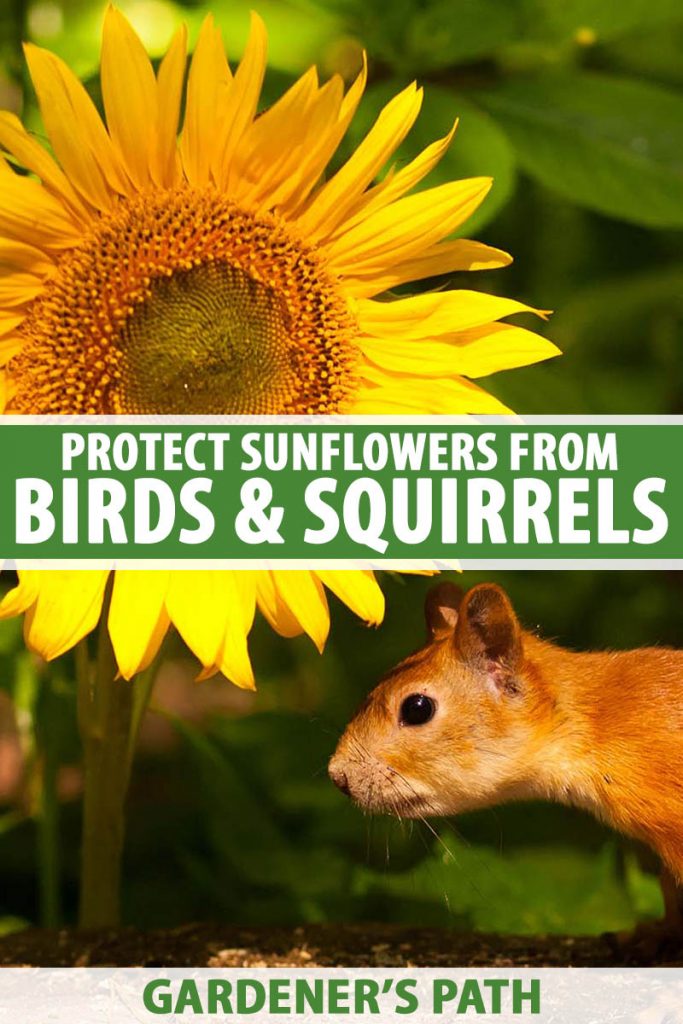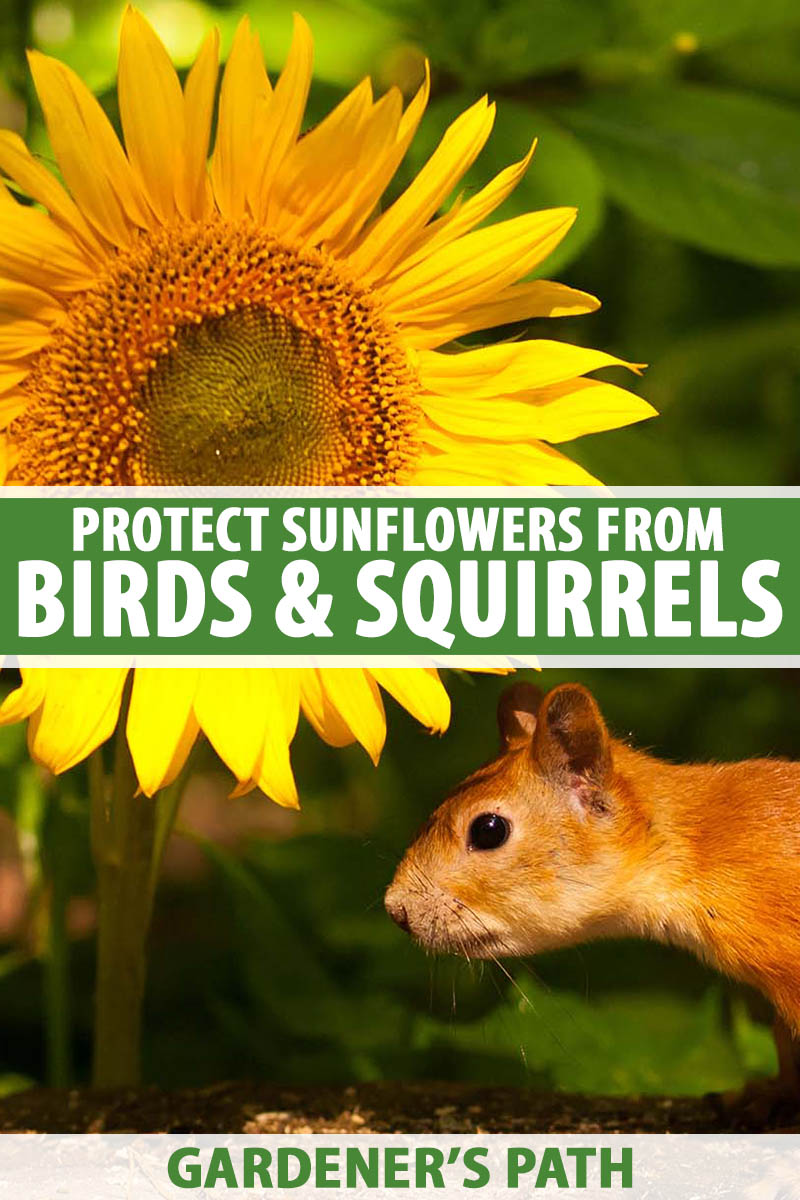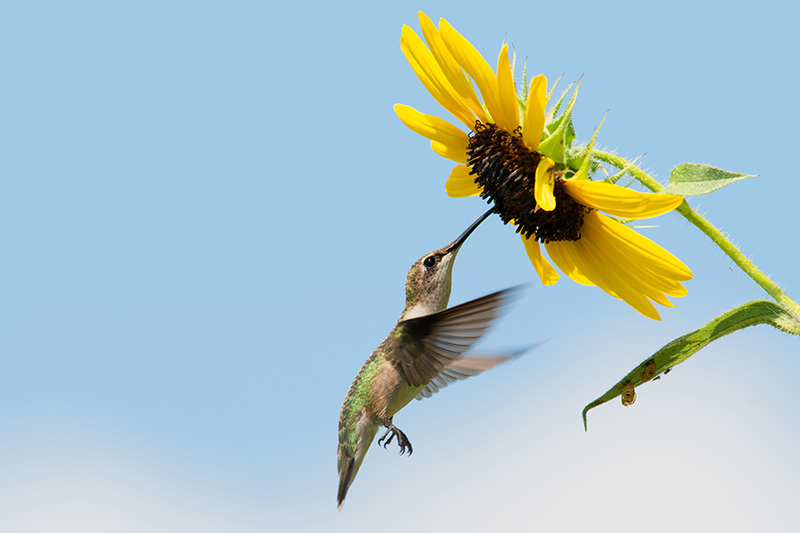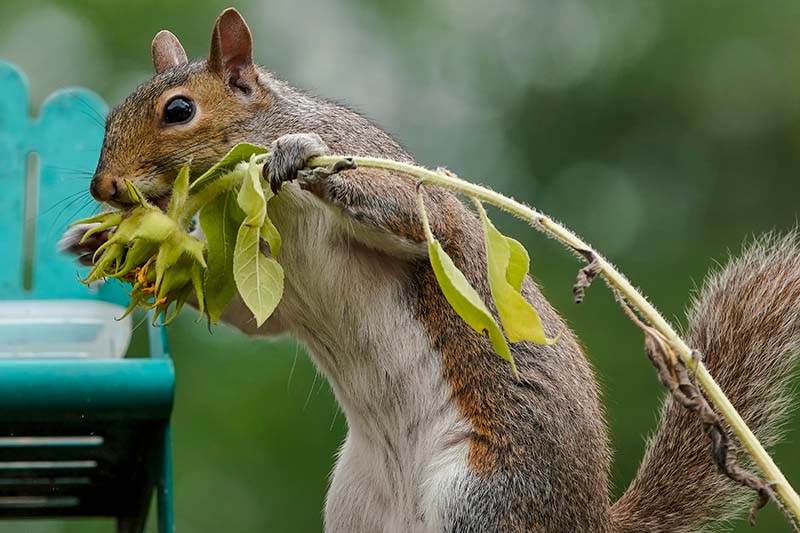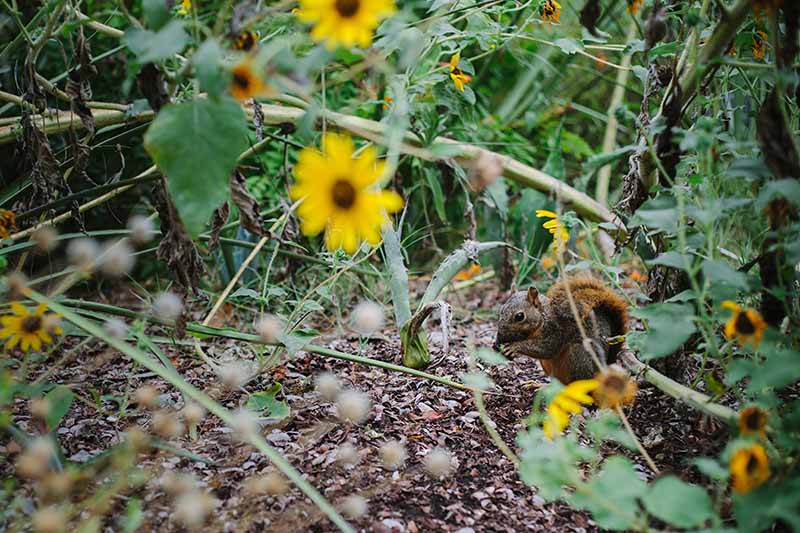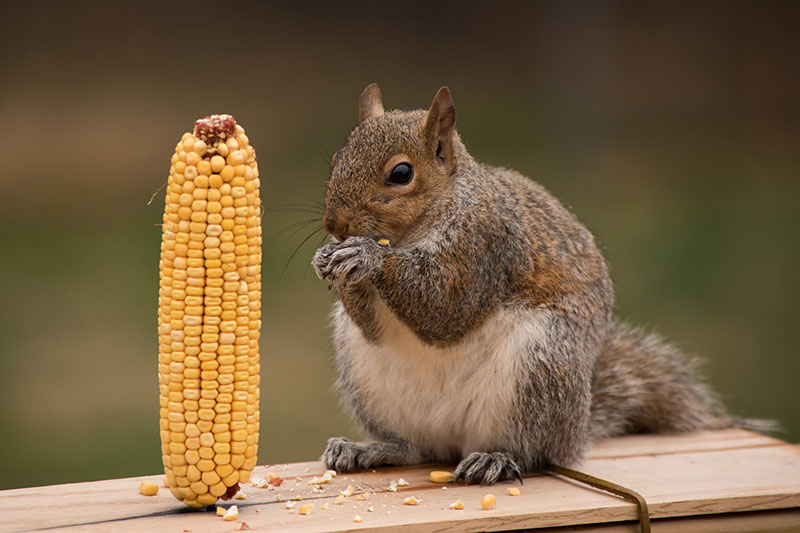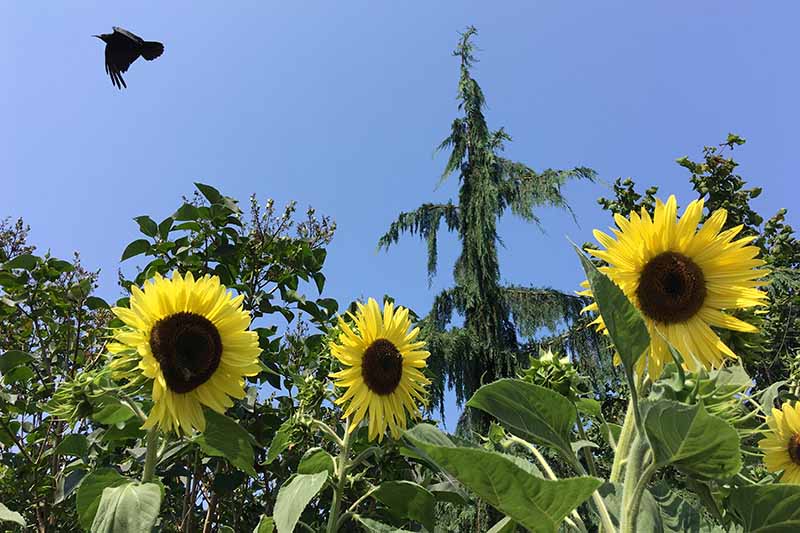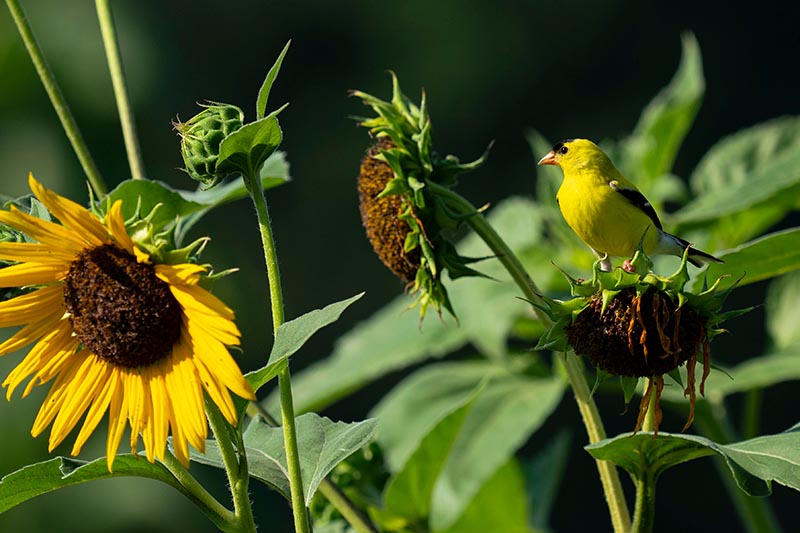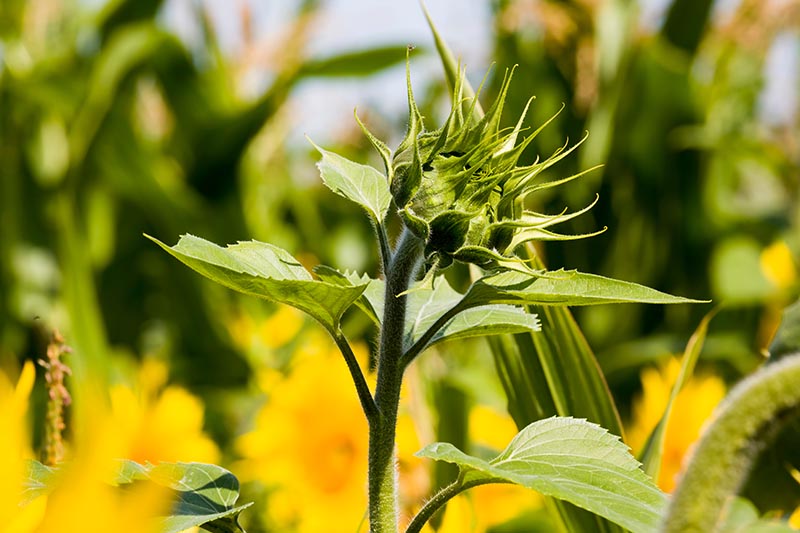This is one of those ironies that confronts gardeners. You may grow sunflowers because they’re so beautiful, but many of us also choose this particular type of flower because they’re beneficial to pollinators and attract wildlife. Some of us also want to grow seed to feed the feathery ones in the cold months. So why does it seem so awful when the local critters help themselves? Weren’t we planning for them to receive this bounty eventually anyhow? We link to vendors to help you find relevant products. If you buy from one of our links, we may earn a commission. It’s all part of the balance we strike between cultivating beauty and sustainability, and fighting off the pests that love our flowers, too. Nor do you need to “let nature run its course” or adopt “live and let live” policies. Oh, I wouldn’t want you to try to kill any of these pests, especially since even lowly squirrels are often protected wildlife in many areas. Besides, new ones will move in if you kill the established population.
But you can still aggressively protect the flowers. There are several techniques I’ll share, and none of them involve any bloodshed. Do be prepared to try them all and switch them up as needed, though. Wildlife can be as determined to enjoy the flowers as the most dedicated gardener. Here are the strategies I’ll cover:
Use Protective Covers
When you’re trying to enjoy the beauty of your homegrown sunflowers, you may consider the tried-and-true tactic of deterring wildlife by putting a cage or heavy net in place to protect your blooms.
While this works well for young bean plants or even petunias, most of these blooms grow to be so tall that cages aren’t practical. Or they’re just not that attractive, which kind of defeats the purpose of growing these sunny favorites. But if you’re more concerned with having blooms to pick for floral arrangements, it’s pretty simple to thwart both birds and squirrels by surrounding the plants with cages that are covered with summer-weight row covers fastened with clothespins. Or strike a balance between looks and coverage by wrapping the heads of a few flowers with pieces of bird netting. It’s not going to be beautiful, but it will protect part of your harvest from getting chomped.
Make Outdoor Spaces Less Appealing
For a more holistic approach that might help to keep pests away from your other flowers and feeders, too, work on making your yard, deck, and driveway less attractive.
If part of your gardening mission is drawing songbirds, you probably don’t want to undo those efforts just to keep cardinals, blackbirds, finches and the like away from certain plants. For squirrels, though, it’s a good idea to protect your sunflowers and their other flowering favorites, like daisies, by making your entire outdoor living space less appealing. So, what’s the first order of business? Tidy up any debris from vegetation. The fruit and nuts that fall from trees and bushes are a proven squirrel lure, for example, so clean them up instead of letting them compost in your yard, garden, or driveway. You’d also be wise to secure your compost bin and garbage cans. They may smell unappealing to you, but bushy-tailed pests will come around just to score the moldy bread, rotting carrots, and other edibles. Also, keep any feeders tidy and free of old kernels and seeds. The area below can draw wildlife looking for grubs, stray kernels, and rotting fruit. Once they start coming around, your carefully tended blooms are extra vulnerable.
Set Up a Separate Haven
To keep wildlife from nibbling or pecking, you can also encourage the animals to meet their food and water needs elsewhere.
Set bird feeders far from your blooms. Also set up bird baths or set out some water close to the food, and nowhere near your precious flowers. I’ve never tried this, but some gardeners swear by planting extra tomatoes near the feed stations, to keep the squirrels content. And here’s another irony for you: Even if you’re growing sunflowers for seed, it’s beneficial to keep nibblers away by offering better (and easier to access) bird seed and feed corn in a separate area of the yard. Sunflower seeds are one option!
Go for Mylar, Skip the Scarecrows
Crows in particular can decimate sunflower blooms, but along with other birds, they’re so beneficial as consumers of grubs, slugs, and other insects they may be worth the sacrifice.
To minimize the damage done, try Mylar tape hung in streamers to frighten these birds away from the tasty blooms. But don’t spend a lot of time or money on the devices advertised to scare birds with ultrasonic noises. According to the Humane Society of the United States, they don’t work. The HSUS also notes that plastic owls and such might scare the birds initially, but “birds are not fooled by plastic owls and inflatable snakes for long.”
Beat Them to the Harvest
When you’re more worried about losing the seeds to furry or feathered friends, you can lightly tie a brown paper bag over each bloom.
Do this as they start dropping petals, and leave the bags in place while the seeds dry. When it’s time to cut the head and harvest, you can simply upend the stalk into the bag and any loose seeds will be captured. For maximum effectiveness, you will have to watch the flowers carefully and note when the seeds begin to form. Make a note in your gardening journal, so you can mark your calendar for next year! I can tell you from experience, a few goldfinches left unattended with even a ‘Mongolian Giant’ flower head can strip every last seed in a matter of hours. And squirrels are even quicker and more devastating.
Try Containers
When the blooms are a moveable feast, why not see if you can control the movement?
Several varieties of sunflower will grow in containers, particularly the dwarf varieties. If you plant a few of these, you’ll be able to move them out of harm’s way when they’re at their tastiest, whether that’s as they start to bloom or when they begin to form seeds. Potted dwarf plants are also easier to cover or cage if you must resort to that, for part or all of the growing season.
Plant More
This is always my favorite type of advice to offer. I believe the very best way to protect sunflower blooms from squirrels and birds is to plant plenty of seeds. You can learn more about growing sunflowers in your garden in this guide.
I don’t mean that you should crowd them, though. That would be counterproductive. If you plan carefully, you can have a succession of flowers for borders, arrangements, and seed saving, starting 50 or so days into the summer, and ending up with long-season choices that take 90 days or more to bloom. You can create your own mix, or leave that to the pros. Eden Brothers, for example, sells a mix of 10 different types of sunflowers that will bloom throughout the season.
Sunny Mix You can also consider varieties like ‘Autumn Beauty’ that bloom over a long period of time – for weeks or even months. If you prefer to stick to just one type, make sure to plant a few more seeds every few weeks of the planting window so wildlife won’t have a chance to eat all the blooms!
They’re Sunflowers, Not Snacks!
My final bit of advice has to do with tenacity. Don’t give up before the critters do! You deserve beautiful sunflowers, and you don’t have to share. Only, please do share if you’ve got your own methods for solving this home garden frustration.
Since squirrels and birds can be so clever about getting what they want and need from your carefully planted flowers, we’re always on the lookout for new tips and techniques for thwarting them. Chime in with your comments below if you’ve found a way to keep feathered and furry diners from devastating your flowering plants. (Please keep it humane, no mentions of bloodshed!) And for more tips on dealing with those charming-but-destructive pests that can plague any garden, read these guides next:
13 Flowering Plants Rabbits Will Leave Alone DIY Guide: How to Install a Deer Fence to Keep Wildlife Out of the Garden How to Keep Moose Out of Your Garden and Orchard
© Ask the Experts, LLC. ALL RIGHTS RESERVED. See our TOS for more details. Product photo via Eden Brothers. Uncredited photos: Shutterstock.
